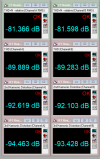I decide to do line REW loopback measurement of SSL 2+ USB Interface not expecting miracles given its 210GBP /280$/ price.
Between 100Hz and 20Khz it is almost straight line which is excellent result. But below 100Hz things are getting funky, with +/-5db starting 43Hz at if levels are on middle for line level.
Four Measurements are taken with with pots for line level on position 2/3/4/5 out of 10.
2 was with lowest distortion, 5 with largest. On position 6 clipping occur.
Position 2 Flatness -> +1.4dB/-0.2dB for 20Hz to 20kHz
Position 3 Flatness -> +2.0dB/-0.2dB for 20Hz to 20kHz
Position 4 Flatness -> +3.9dB/-0.1dB for 20Hz to 20kHz
Position 5 Flatness -> +10.8dB/-0.1dB for 20Hz to 20kHz

Distortion at position 2:

Distorsion at position 5:

Pity that I cannot measure Mic preamplifier as loopback is clipping when I switch to Mic setting.
If anyone have any idea how I can measure Mic preamp loopback please let me know.
Between 100Hz and 20Khz it is almost straight line which is excellent result. But below 100Hz things are getting funky, with +/-5db starting 43Hz at if levels are on middle for line level.
Four Measurements are taken with with pots for line level on position 2/3/4/5 out of 10.
2 was with lowest distortion, 5 with largest. On position 6 clipping occur.
Position 2 Flatness -> +1.4dB/-0.2dB for 20Hz to 20kHz
Position 3 Flatness -> +2.0dB/-0.2dB for 20Hz to 20kHz
Position 4 Flatness -> +3.9dB/-0.1dB for 20Hz to 20kHz
Position 5 Flatness -> +10.8dB/-0.1dB for 20Hz to 20kHz
Distortion at position 2:
Distorsion at position 5:
Pity that I cannot measure Mic preamplifier as loopback is clipping when I switch to Mic setting.
If anyone have any idea how I can measure Mic preamp loopback please let me know.




